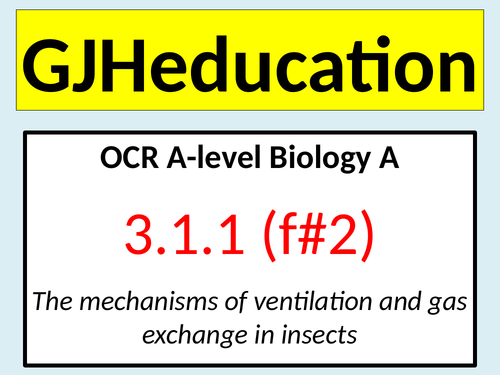



This lesson describes the mechanisms of ventilation and gas exchange in insects. The PowerPoint and accompanying worksheets are the part of the second lesson in a series of 2 lessons which have been designed to cover the details that are set out in point 3.1.1 (f) of the OCR A-level Biology A specification. The first lesson in this series describes ventilation and gas exchange in bony fish
In the previous lesson, the students were introduced to the different circulatory systems of mammals and bony fish and this knowledge is checked upon at the start of this lesson. This is relevant because the open circulatory system of an insect explains how oxygen is not transported in the blood but instead is absorbed from the body fluid that bathes the tissues. The next part of the lesson describes the structure of the spiracles, tracheae and tracheoles in the tracheal system and explains how this system is responsible for the delivery of oxygen to the open end of the tracheole for gas exchange with this fluid. As the tracheae are supported by chitin, which is similar in structure and function to cellulose and keratin respectively, a series of exam-style questions are used to challenge the students on their knowledge of those polymers from module 2.1.2 (biological molecules). As always, the mark scheme is embedded in the powerpoint so students can assess their understanding and progress. The final part of the lesson describes how squeezing of the tracheoles by the flight muscles and the changes in the volume of the thorax as a result of the movement of the wings are similar to mechanisms observed in mammals.
Get this resource as part of a bundle and save up to 33%
A bundle is a package of resources grouped together to teach a particular topic, or a series of lessons, in one place.
Module 3: Exchange and transport (OCR A-level Biology A)
This bundle contains 18 detailed and engaging lessons which cover the following specification points in module 3 (Exchange and transport) of the OCR A-level Biology A specification: 3.1.1: Exchange surfaces * The need for specialised exchange surfaces * The features of an efficient exchange surface * The structures and functions of the components of the mammalian gaseous exchange system * The mechanism of ventilation in mammals * The mechanisms of ventilation and gas exchange in bony fish and insects 3.1.2: Transport in animals * The double, closed circulatory system in mammals * The structure and functions of arteries, arterioles, capillaries, venules and veins * The formation of tissue fluid from plasma * The external and internal structure of the heart * The cardiac cycle * How heart action is initiated and coordinated * The use and interpretation of ECG traces * The role of haemoglobin in transporting oxygen and carbon dioxide * The oxygen dissociation curve for foetal and adult haemoglobin 3.1.3: Transport in plants * The structure and function of the vascular systems in the roots, stems and leaves * The transport of water into the plant, through the plant and to the air surrounding the leaves * The mechanism of translocation As well as the detailed A-level Biology content of the PowerPoint slides, the resources contain a wide range of tasks including guided discussion points, exam-style questions and quiz competitions which will engage and motivate the students
Module 3.1.1: Exchange surfaces (OCR A-level Biology A)
This lesson bundle contains 5 lesson PowerPoints and together with their accompanying worksheets, they will engage and motivate the students whilst covering the following specification points in module 3.1.1 (Exchange surfaces) of the OCR A-level Biology A specification: * The need for specialised exchange surfaces * The features of an efficient exchange surface * The structures and functions of the components of the mammalian gaseous exchange system * The mechanism of ventilation in mammals * The mechanisms of ventilation and gas exchange in bony fish and insects Found interspersed within the detailed A-level Biology content in the slides are current understanding and prior knowledge checks and these are followed by displayed mark schemes to allow students to assess their progress. There are also differentiated tasks, guided discussion periods and quiz competitions that introduce key values and terms in a fun and memorable way If you would like to see the quality of lessons included in this bundle, then download the mammalian gaseous exchange system and ventilation and gas exchange in insects lessons as these have been uploaded for free
Something went wrong, please try again later.
Great as always, thanks!
Report this resourceto let us know if it violates our terms and conditions.
Our customer service team will review your report and will be in touch.